Home | Front Page | Index | Blog | New | Contact | Site Map
California | Photos | Map
Los Angeles:
Doings | Eatin' | Bldgs | More | Hancock Park
Caltech:
Campus | Reunion | Lloyd House | JPL
Yosemite Valley
Yosemite Falls
Nevada Fall

Britain 2002
USA 2001
USA 2002
USA 2003
Virginia
North Carolina
South Carolina
Georgia
Florida
Alabama
Louisiana
Texas
Arizona
California
Nevada
Index 1999-2002
Index 2002-2003

Los Angeles City Hall and Civic Center |
While in the LA area we spent some serious time looking at buildings just because we like buildings. Twice we went to Downtown Los Angeles to walk about, specifically looking for two new buildings and what was new and what was changed.
Hardly changed at all was the Los Angeles City Hall, a 20-story building that made us think of the Louisiana State Capitol. A better way of putting that would be to say that when we were in Baton Rouge and saw the Huey Long creation, we saw the similarity to a building that Gerry "grew up with." Every era has its architectural fashions. In the 1920s the American fashion for Greek temples was temporarily over and soaring monuments were in. In the Los Angeles area the Pasadena and Beverly Hills City Halls also were built under this influence.
Gerry was raised in Hawthorne, one of the approximately one hundred cities in Los Angeles County. From the tree house in his yard he could see the Los Angeles City Hall, about 11 miles away to the northeast. (On very clear days he could see the 10,000-foot mountains 50 miles to the east.) When he was young, and before there were suburban shopping centers, the family would make one or two trips a year by street car to downtown. Then one of his greatest thrills was to sneak away for a while and go to the top floor, the 13th, of the May Department Store and look out a stairwell window and marvel at the height.
City hall was for a long time the tallest building in the area. Due to earthquake danger, for many years buildings here were restricted to 13 storys; at 20 storys the City Hall soared above all others. As time passed, as the city and the metropolitan area grew in population and need for office space, and as earthquake-resistant designs were found, it made sense to allow much taller buildings. But conservatism and (Gerry suspects) desire that City Hall remain the tallest building, put off for many years permission to go sky high. Eventually that did happen and downtown LA got a real skyline.

Downtown Los Angeles seen across Echo Park lake |
Echo Park, being close to downtown, is one of the oldest parks and areas in the City of Los Angeles. If Gerry's memory is right (and he has his doubts), his parents used to stroll his older brother and sister around this lake. Today, with many new tall buildings downtown, the view is much different than it must have been in the 1930s. Now visible is LA's tallest building, about 1000 feet high; about 3 times as high as the City Hall surrounded by other new, tall buildings that would all tower over City Hall if they were side by side. In the general area of Echo Park there are many 1930s single-story, single family houses. As the suburbs grew this area became less fashionable and their relative value declined. The moment is near, we think, for gentrification to take off. Certainly, if it weren't for all those exceptions - e.g. we don't want to settle down, its too smogy, we like snow once in a while - we'd be among the leaders.
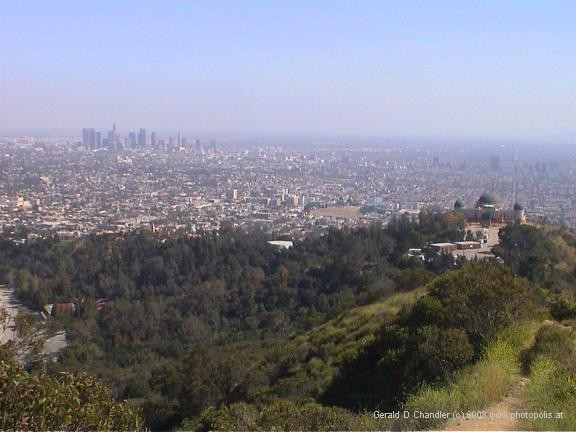
View from Mt Hollywood in Griffith Park |
Just two miles to the west of Echo Park is the southeast corner of Griffith Park, the site of the Observatory. This has often been a film location; it appeared, for example, in "Rebel Without a Cause", in which James Dean starred in 1955. From it or on the hill just above it all of downtowns high buildings can be seen. In addition, to the south also visibile are a cluster of tall buildings on Wilshire Blvd, one of the dozen or more "high rise" districts in the metropolitan area. When the haze (smog) is not too bad the view extends out to about 20 miles; on the above right the discerning eye can see the slopes of Palos Verdes, hills that are about 2000 feet high. Beyond them is the Pacific.
We stayed in the Hollywood Inn Motel on Alvarado; that is about halfway from Griffith Park to Downtown. Out of sight to the right of this picture, but visible from our room at the Hollywood Inn, is the famous "Hollywood" sign.
Super Modern Architecture
There were two really new buildings that we wanted to see in downtown. One was the new Catholic Cathedral, which opened in October, 2002 and the other was the Walt Disney Concert Hall, to be opened in October, 2003. Both are modern, or post modern, or whatever term applies. But they are very, very different from one another.
The Old Catholic Cathedral was damaged by the 1994 Northridge earthquake. The Catholic Church wanted to pull it down and replace it with a bigger, better building. Preservationists objected to this; they wanted it saved. The Church objected, asking who was going to pay for the restoration, which would cost far more than a new building. The ultimate compromise was that the Church gave the building to the preservationists who raised money to restore it and convert it to a museum.
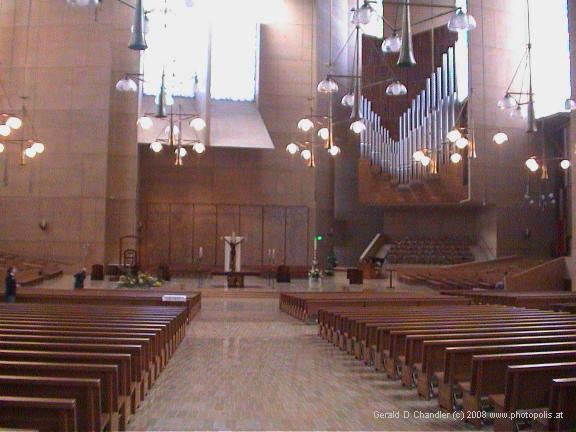
Roman Catholic Cathedral |

Cathedral Ceiling |
The new building is what the layman (i.e., we) might call "Post Modern Spanish Colonial." It certainly has hints of the colonial era but is basically very modern. For us, the result is that the new exterior has none of the charm of a colonial mission. (We haven't shown a photo of it because it is too plain up close, and we couldn't get a good perspective view.)
But the inside is very different. Here, we were very pleased. Kudos to the architect and planning committee. A superb solution was found for the need for a large open space for a growing congregation. The interior is light and airy and pleasing and seems as if it would work excellently for a service (which we did not attend).

Painting from destroyed Catholic Cathedral |
Parts of the old church were brought as decorations for the new church. Some of these made a nice connection with the past.
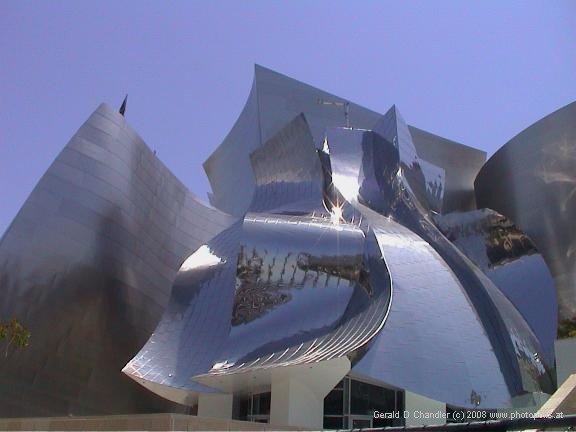
Walt Disney Hall by Frank Ghery |
The other building we wanted to see, the new Disney Concert Hall, is famous before it opens because it is a Frank Ghery design. We have to disclose right away that we are not among his greatest fans. We didn't particularly like his office building in Prague and we didn't like the design project for the expansion of the Corcoran Gallery in Washington, DC. So we didn't expect to particularly like this. But we wanted to see it.
Bottom line: The outside (according to Gerry and denied by Jan) has a certain charm, if you like "Star Wars" and the like. The curvy titanium shell gives you the idea you may be on another planet. But, like the Prague building (and probably intentionally, as with every building that Ghery is commissioned to make) it doesn't fit in well with the neighbors. It occupies a whole city block and neither matches the older buildings nearby nor is enhanced by the non-descript parking lot across one of the blocks. We didn't see it inside, because it is not open. We hope you don't have to wait five years for our next report to learn what sort of concent hall it is.
Before a brief tour of other parts of the city let's get some more views of the western part of downtown Los Angeles. As with so many other major cities, as big buildings have gone up, the night life has gone out. In the day there are plenty of office workers about, but there are now comparatively few residences. East of the center this is far from true. Mexicans have taken over the very center, Japanese the near eastern sides, and, if one goes as far out as Montery Park, one finds a Chinese majority. In all of these areas, there is a vibrant (if less anaesthestic) street life.
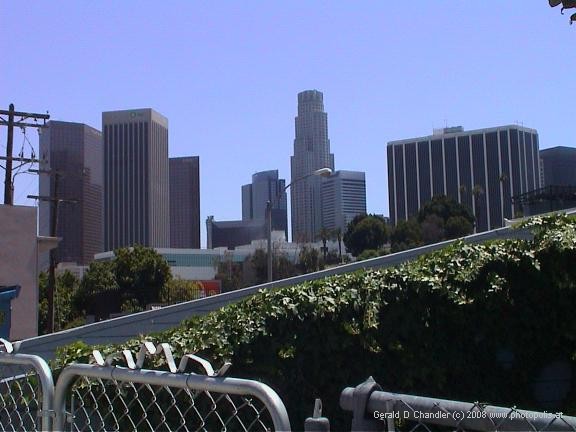
Downtown LA seen from Third Street near Figeroa |
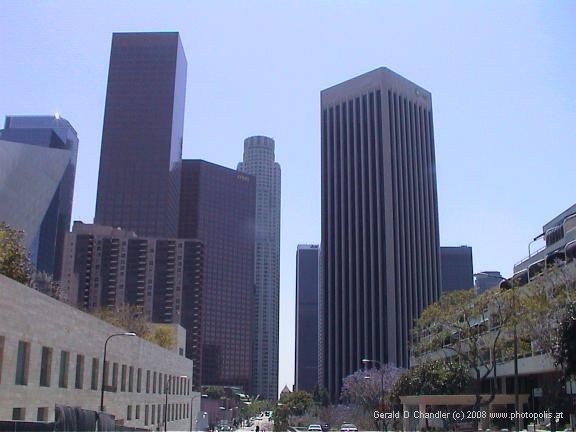
LA Skyscrapers from Street |
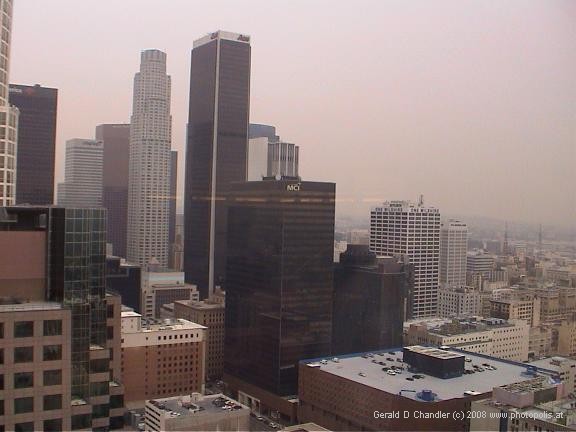
LA Skyscrapers 30th Floor |
A perfect example of this is Bunker Hill and Angel's Flight. From shortly after the city's founding until the 1960s there was a vibrant community on the top of this 150-foot high hill. Like Monmartre in Paris, for most of its existence it was a comparatively cheap place to live because only the poorer would accept struggling up the hill. And, like Monmartre, it got a funicular, Angel's Flight, that could carry the tired or package-laden to the top. Because it wasn't free, it was still a low-rent district, where many people crowded into large Victorian rooming houses. Early in their marriage, in the 1930s, Gerry's father and mother roomed at the top of Bunker Hill. They rarely put out the 5 cents (equivalent now to perhaps $2) for a ride home.

Angel's Flight area with tall buildings |
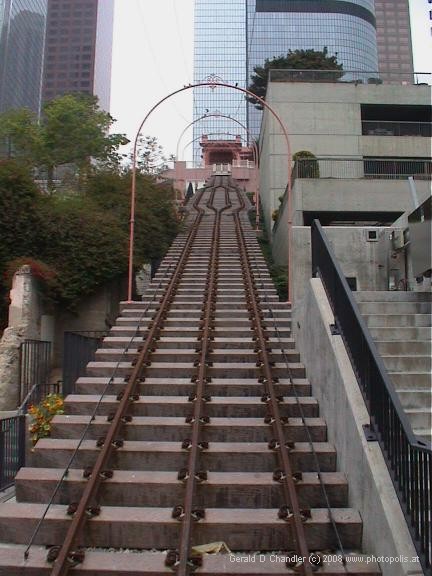
Angel's Flight looking straight up tracks. |
In Paris, Monmartre became the home of many artists and then the destination of many tourists who wanted to imbibe a long-terminated bohemian existance. Bunker Hill didn't have the same fate. Starting in the 1980s the out-of-fashion Victorian houses were pulled down, much of the hill was removed, and Angel's Flight taken down. Rising in their stead were mighty office buildings that would dwarf City Hall if they were next to it, but dominate it now because of the extra height of the hill. Then, in an almost graceless "mea culpa" a bowdlerized Angels Flight was rebuilt, supported not by a diminished hill, but by concrete pillars.
In the center of downtown is Pershing Square, named after General John "Black Jack" Pershing who distinguished himself in the chase for Pancho Villa and in World War I. It seems that city planners cannot figure our what to do with such squares. When they were origianlly built they must have served as lungs for the areas about them. Then, in the age of the automobile, when so many people moved out of the center and commuted back for work, many of them had parking garages installed under them in the 1960s. Such was the fate of Independence Mall in Philadelphia, Union Square in San Francisco, and Los Angeles' Pershing Square. What looked fine, even wonderful, in artist's pastel renderings, were or became failures. They lost life and got bums and decay. The story is not unique to America; we've seen it even in Paris and to some extent in the major squares of Mexico we recently saw, such as in Monterrey. One success, has been Union Square in New York City. And that is probably because the subways and stations underneath it and the multitudes coming and going have always keep some life there.

Pershing Square |
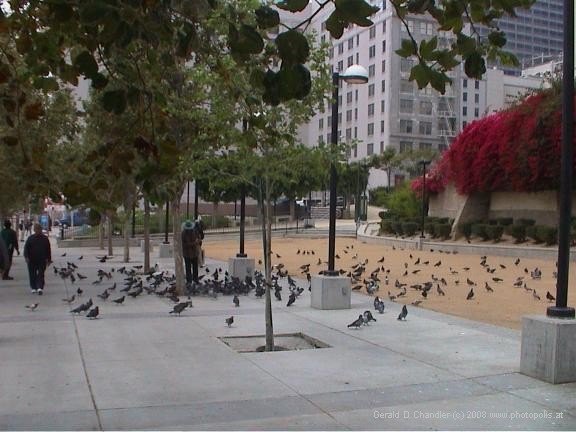
Pershing Square Pigeons |

Pershing Square Fountain |
As we saw Pershing Square it had been refurbished. While things may be better, we're sorry to say it is not a great success as a public place. We've read about the $250 million improvements to Philadelphia's Independence Mall; we wonder what we will think when we see it.
Let's end this review on a positive note. In the 1920s (or was it the 1930s?) the Artists Building was constructed as a speculative home for — you guessed it — artists. This comes as a surprise when we look at it today, we who are used to artists taking over decrepit lofts, etc, and through their own sweat making them into studios. In fact, it was a commercial failure at its original use and became a standard office building. That is what it is again, but it is more beautiful than ever, having been recently restored.

Main Library |
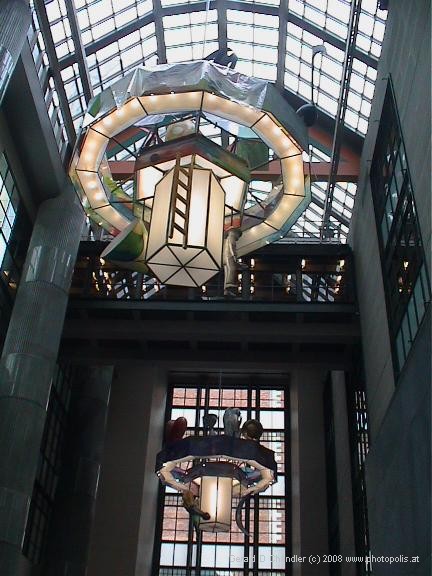
Main Library Arium |
Much the same can be said about the main public library, at least as concerns beauty and restoration. Also built in the 1930s (or was it 1920s) it was a fine art deco building. But age and inadequacies led to proposals to tear it down. Instead (hallelujah! So what if it cost (other people's) money!) it was not only restored but doubled in size. We especially like the atrium that houses the four-level escalators. The lamps there are wonderful.